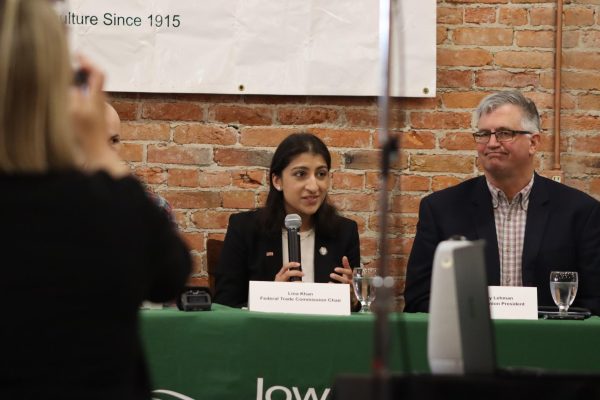Turkish Night celebrates vibrant culture

Bahri Karacay, on violin, plays a traditional Turkish song during the Turkish Night celebration, Tuesday, March 3, 2009, in the Great Hall of the Memorial Union. Karacay is the lead singer of TURKANA, which is a band composed of both Turkish and American musicians. Photo: Logan Gaedke/Iowa State Daily
March 3, 2009
Akshali Gandhi — Daily Staff Writer
While on active military duty in 2000, John Griswold was sipping coffee at a local bistro in Turkey when a young Turkish woman walked by.
“She was so beautiful that I had to introduce myself,” said Griswold, a 2006 ISU alumnus.
He went on to marry her, and the couple settled in Iowa. Nine years later, John and Sibel Griswold clapped their hands and snapped their fingers to the rhythms of the traditional saz, as well as modern keyboard, drums and electric bass, as they listened to Turkish fusion pop in the Great Hall of the Memorial Union on Tuesday night.
“I’m always curious about different cultures,” Griswold said. “We really enjoy the music because it brings back so many memories of [being in] Turkey.”
Turkish Night, an event put on by Turkish Student Association, made a cultural comeback for the second year after a five-year gap.
The event showcased Turkish culture as a “rich” mix of European, Asian and Middle Eastern influences, said Emrah Simsek, graduate student in mechanical engineering and assistant scientist for the Ames Laboratory.
“We are a mix of cultures – an example to the Middle East and a bridge to Europe – connecting east and west,” he said.
Program highlights included backgammon, photo slideshows, belly dancing performances, a virtual tour of the country, free dancing and live music by the traveling musical group Turkana.
Alison Backous, sophomore in kinesiology and health, performed belly-dancing. Although it was mostly Arabic styles, the group’s numbers also included two Turkish dances.
“Turkish [belly-dancing] has a little bit of a different beat to it,” Backous said.
Even with all the activities, the night was not over without a taste of Turkish cuisine. The menu included Dalyan meatloaf, a rice-like dish of bulgur pilav, shepherd’s salad and the famous international pastry baklava.
As president of the association, Ozkan Ozer, graduate student in mathematics, knew he wanted to incorporate the sugary sweet, slightly crispy sandwich dessert into Tuesday’s event.
“Almost every country makes baklava. But this is Turkish baklava,” Ozer said. “We use cane sugar instead of honey, and it is generally drier and less viscous, with pistachio as the main ingredient.”
Setting aside his love of baklava, Ozer also spoke about the need to showcase Turkey as a cultural crossroads.
“So many people don’t know where Turkey is,” he said. “They have this misconception that it is Arabic, when it is not – it is a mix.”
For Griswold, marrying into Turkish culture was worth crossing cultural barriers.
“Once you get past the little differences, it’s so much more worth it to be in someone else’s shoes and get to know where they grew up,” he said.
How to make Baklava, a traditional Turkish pastry dessert:
“It’s made with really thin slices of philo dough, which comes in packages of leaves here. What you do is basically get one or two leaves at a time, put it on a buttered baking tray, and then butter every layer. When halfway through, add fine ground pistachio, walnuts, or some kind of nuts. Then you put the rest of the philo dough layers on top of it again, buttering every other layer. It is cut into rectangular slices. Bake it in the oven until thin and crispy. In the meantime, prepare a syrup of butter and sugar. When the baklava is done baking and cooling, pour the hot syrup on the cold baklava, and watch it sizzle. This syrup, after an hour or two, is absorbed as it sits on the baklava. Then you can recut it and serve. It’s a lot of layers, but not like lasagna. Lasagna only has two or three layers; baklava has more.”
— Information from Emrah Simsek, graduate student in mechanical engineering and assistant scientist at Ames Laboratory and active member of Turkish Student Association
Common phrases in Turkish:
My name is – Benim adim
How are you? – Nasilsiniz?
Hello – Merhaba
Good morning – Gunaydin
I’m fine, thank you – Lyiyim, tesekkur ederim
Thank you – Tesekkur ederim
Friend – Arkadas
Yes/No – Evet/Hayir
— Information gathered from official Turkish Culture and Tourist Offices Travel Directory booklet
















